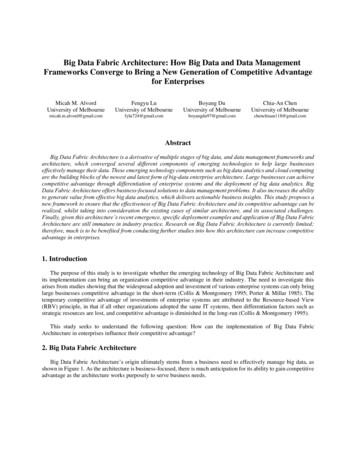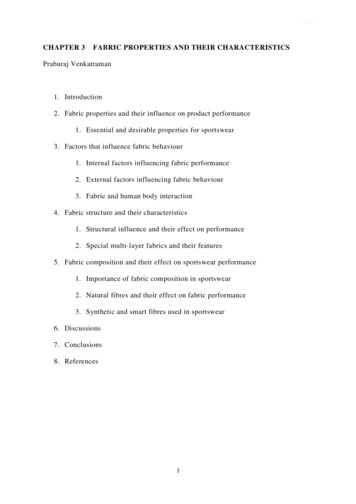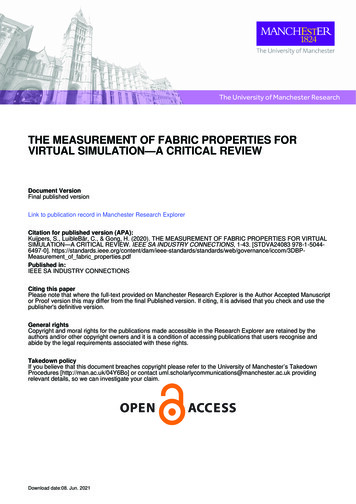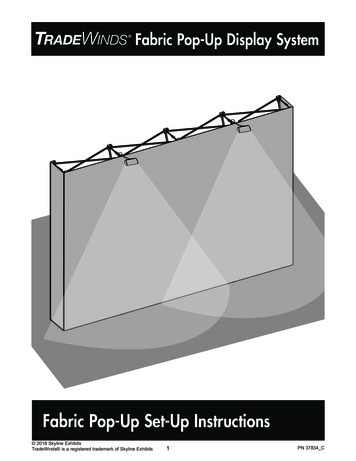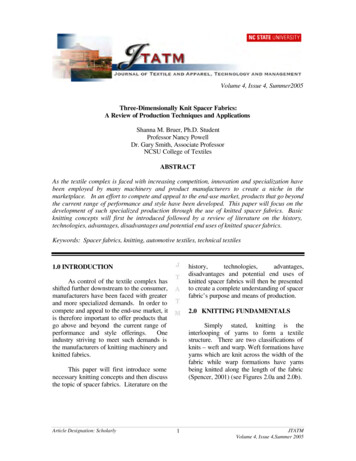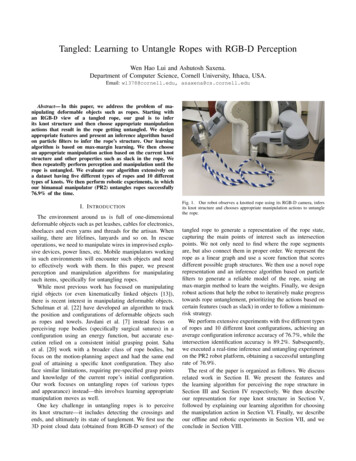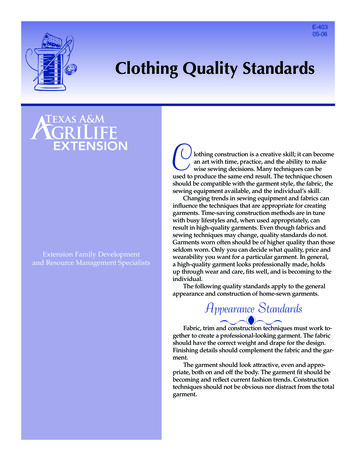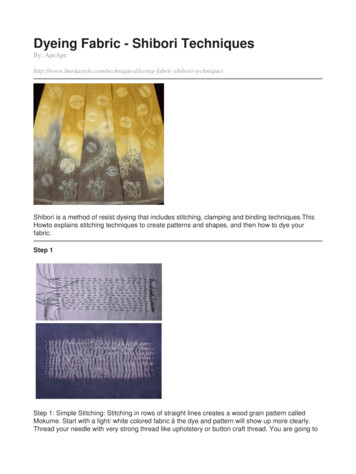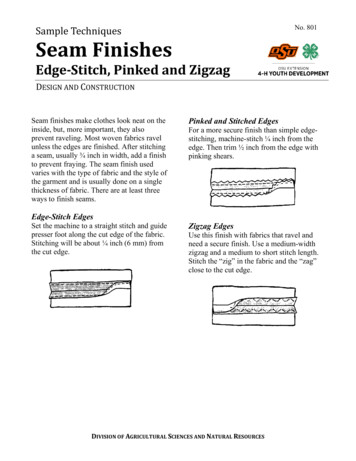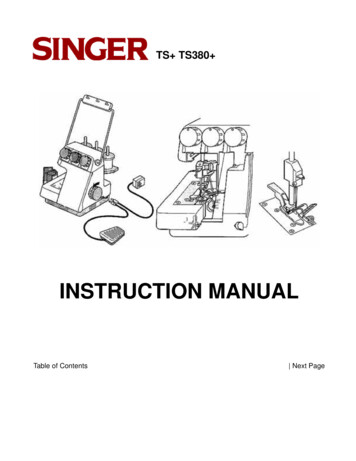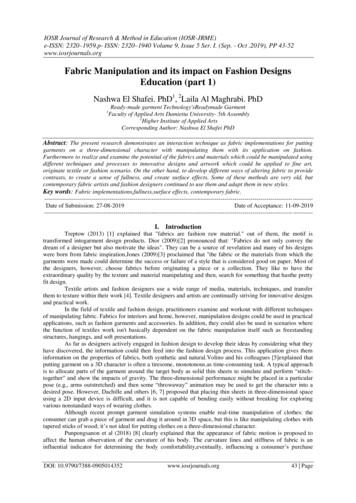
Transcription
IOSR Journal of Research & Method in Education (IOSR-JRME)e-ISSN: 2320–1959.p- ISSN: 2320–1940 Volume 9, Issue 5 Ser. I. (Sep. - Oct .2019), PP 43-52www.iosrjournals.orgFabric Manipulation and its impact on Fashion DesignsEducation (part 1)Nashwa El Shafei. PhD1, 2Laila Al Maghrabi. PhDReady-made garment Technology'sReadymade GarmentFaculty of Applied Arts Damietta University- 5th Assembly2Higher Institute of Applied ArtsCorresponding Author: Nashwa El Shafei PhD1Abstract: The present research demonstrates an interaction technique as fabric implementations for puttinggarments on a three-dimensional character with manipulating them with its application on fashion.Furthermore to realize and examine the potential of the fabrics and materials which could be manipulated usingdifferent techniques and processes to innovative designs and artwork which could be applied to fine art,originate textile or fashion scenario. On the other hand, to develop different ways of altering fabric to providecontrasts, to create a sense of fullness, and create surface effects. Some of these methods are very old, butcontemporary fabric artists and fashion designers continued to use them and adapt them in new styles.Key words: Fabric implementations,fullness,surface effects, contemporary -------------------------------- ---------Date of Submission: 27-08-2019Date of Acceptance: ----------------------------------- ----------I. IntroductionTreptow (2013) [1] explained that "fabrics are fashion raw material." out of them, the motif istransformed intogarment design products. Dior (2009)[2] pronounced that: "Fabrics do not only convey thedream of a designer but also motivate the ideas". They can be a source of revelation and many of his designswere born from fabric inspiration.Jones (2009)[3] proclaimed that "the fabric or the materials from which thegarments were made could determine the success or failure of a style that is considered good on paper. Most ofthe designers, however, choose fabrics before originating a piece or a collection. They like to have theextraordinary quality by the texture and material manipulating and then, search for something that hasthe prettyfit design.Textile artists and fashion designers use a wide range of media, materials, techniques, and transferthem to texture within their work [4]. Textile designers and artists are continually striving for innovative designsand practical work.In the field of textile and fashion design, practitioners examine and workout with different techniquesof manipulating fabric. Fabrics for interiors and home, however, manipulation designs could be used in practicalapplications, such as fashion garments and accessories. In addition, they could also be used in scenarios wherethe function of textiles work isn't basically dependent on the fabric manipulation itself such as freestandingstructures, hangings, and soft presentations.As far as designers actively engaged in fashion design to develop their ideas by considering what theyhave discovered, the information could then feed into the fashion design process. This application gives theminformation on the properties of fabrics, both synthetic and natural.Volino and his colleagues [5]explained thatputting garment on a 3D character is often a tiresome, monotonous.as time-consuming task. A typical approachis to allocate parts of the garment around the target body as solid thin sheets to simulate and perform “stitchtogether” and show the impacts of gravity. The three-dimensional performance might be placed in a particularpose (e.g., arms outstretched) and then some “throwaway” animation may be used to get the character into adesired pose. However, Dachille and others [6, 7] proposed that placing thin sheets in three-dimensional spaceusing a 2D input device is difficult, and it is not capable of bending easily without breaking for exploringvarious nonstandard ways of wearing clothes.Although recent prompt garment simulation systems enable real-time manipulation of clothes: theconsumer can grab a piece of garment and drag it around in 3D space, but this is like manipulating clothes withtapered sticks of wood; it’s not ideal for putting clothes on a three-dimensional character.Punpongsanon et al (2018) [8] clearly explained that the appearance of fabric motion is proposed toaffect the human observation of the curvature of his body. The curvature lines and stiffness of fabric is aninfluential indicator for determining the body comfortability,eventually, influencing a consumer’s purchaseDOI: 10.9790/7388-0905014352www.iosrjournals.org43 Page
Fabric Manipulation and its impact on Fashion Designs Education (part 1)decisions. In the textile industry, the curvature lines and stiffness of garments are significantly considered tosupply customers with favorable impressions.II. The Research Plan.II.1.The problem of research and limits:The conceptual frameworks with the combination of two different technical styles might producemodern and contemporary artworks.For organising the experience of the research, the analytical approach should be used in monitoring andstudying the concept of the rules of different types of lines on fashion design.II.2.Research question1. To what extent could the techniques of fabric manipulation as an input to the integration of the rules ofdifferent types of fabrics in fashion design serve the body shape?2. Should the field of fashion artworks combine with explaining the aesthetic of different types of manipulationthat could help the fashionable dress model?II.3.Research Importance1. The research emphasizes the relationship between fabric manipulation and the construction of a dressfashion trend.2. Fashion designers have to understand the mechanisms of different fabric manipulation for creating aestheticvalues.3. The types of fabric manipulation should meet the needs of the body Figure group / occasion and be able toexpress the individuality as well as the creativity of the designer.II.4.Research Goals1. The research seeks to draw a shed light on the fabric manipulation techniques practices and the worksperformed on fashion design through the effect of types of manipulation.2. The research supports the field of fashion designers and work in the college specifically in terms ofexperimental and formative terms that carry the methods of applying fabric manipulation techniques and theaesthetic innovated dimensions.3. The research improves the appreciation of beauty through the fantastic framework and dimensional types ofthe body as well as diverse values.4. The research unlocks the students' intelligent horizons to inside the world of fashionable art and its actualapplication of use of this idea.5. The research help the students to be able to express inspiration, thoughts and a natural instinctive state ofmind deriving by knowing the type of technique.II.5.Search Limits1. The work is mainly dealing with student's ready-made garment specially and, the beginners of fashiondesigners in general.2. Emphasis on the body figure and designers need to consider for whom they are styling what type ofgarment they promote, and for what particular occasion.II.6.Research hypothesesThe combination, and assemblies, between the different types of fabric manipulation, renovates, andexpands the art fashion field in the college with modernistic and synchronous designs.III.The Art of Manipulating FabricIII.1.What is Fabric Manipulation?Fabric manipulation is a three-dimensional approximation of clothing from flat patterns. There arenumerous ways to manipulate and redesign fabric or control it so as to become 3-dimensional forms. Duringhistory, people have invented different ways of modifying fabric to provide contrasts, to create a feeling offullness, and create a surface and different textured effects. Some of these methods are very old, but the artistsof contemporary fabric continue to use and integrate them in innovative ways.III.2.Fabric manipulation–Wolff and singer (2013) [9, 10] explained that the large variety of techniques, applications, andmaterials enables the students to create a unique textile surface with rich and exotic textures, gorgeous color andDOI: 10.9790/7388-0905014352www.iosrjournals.org44 Page
Fabric Manipulation and its impact on Fashion Designs Education (part 1)three-dimensional manipulated forms. There is an array of new and innovative techniques that can be madewith exploration and experimentation of reshaping the fabrics.III.3.Types of manipulation.III.3.1.Gathering.Gatheringcould be done by hand or by machine. Just the threads, elastic materials. Gathering however,isonly one or both edges to produce different effects, as does the volume and shape of fabric as shown at Photo(1).III.3.2.ShirringShirring means gathering the fabric with multiple rows of stitching. These rows can be stitched all inone direction or in two different directions crossing each other. It could also do shirring pattern by stitching forexample wavy- or angled lines as each style produces different outcomesas at Photo (3).III.3.3.RushingRushing is a related method, in which layers of fabric are gathered on parallel sides and then sewn to alayer underneath. You sometimes see this fabric technique on the tiers in the sides of prom and party dressesasat Photo (4).III.3.4.RufflesParute (2018) [11].Narrated that the general effect of fabric ruffles can show similarly flounce, whereruffles are the same style of detail and occasionally used interchangeably. From a pattern and construction view,however, they are shaped in very different forms. Generally speaking, a ruffle is constructed by using a piece ofa rectangle fabric that is gathered up into a smaller area. When ruffle is stitched into a seam line, such as on thewaistline of a skirt, the excess fabric fullness will be obviously gathered on the stitch line originating smallpleats of fabric.Ruffle is often used as neat as smart in an appearance on clothes and is a pleated piece of decorativefabric. The word ruffle is mysterious, but it might be from the Low German word ruffelen which means towrinkle. Moreover, a fancy wrinkle at the bottom of the dress is ruffling fabric manipulation [12].III.3.5.FlouncesFlounce - according to Collins dictionary[13], a flounce is a piece of cloth that has been stitched intofolds and fixed around the edge of something, for example a gown with a flounce around the hem, or a skirt,tablecloth, curtain as at Photo(5,6).In contrast, a flounce is mostly based on a more circular model; otherwise, more like a donut-shapedpattern. The inside edge of the “donut” is the edge that is stitched into the seam line while the outside edge ofthe donut originates fullness at the hemlineas Photo (7).DOI: 10.9790/7388-0905014352www.iosrjournals.org45 Page
Fabric Manipulation and its impact on Fashion Designs Education (part 1)III.3.6.FrillAccording to Merriam-Webster dictionary [14], frill a gathered, pleated, or bias-cut fabric edging usedon clothing. Figuratively it also refers to something decorative or useful and desirable but not essential. Thefollowing photos are showing some sort of Flounces,.III.3.7.GodetThere are different methods in which fabric can be decreased in size to suit the body curve or enlargedto innovative volume. One way of creating fullness and volume in a skirt or dress is by inserting panels into thefabric and these are commonly known as geodes.Nicoll Collections (2012) [15] showed that the style of the godet pattern has been used to create skirtsand dresses that tend to be smooth over the waist and hips line and to create fullness through the skirt. Inaddition, the outline of the garment's body has lengthened the line of the garment down before it flowedsmoothly into the fuller folds of fabric. A godet skirt is a triangular piece set into a skirt gore to give addedDOI: 10.9790/7388-0905014352www.iosrjournals.org46 Page
Fabric Manipulation and its impact on Fashion Designs Education (part 1)fullness to a flared hem edge. Godet makes the skirt flare and eventually creates more fullness to the skirt asshown at Photo (12 A, B, C, D).III.3.8.PleatingKume and his colleague (2015) [16] have defined the Pleats as folds established on a piece of fabric.According to the technical language, the related terms have differences. The principles of pleats are importantby which the characteristic of pleats as some sort of texture is one of the fundamental elements of design,aesthetic tools and the means by which designers can subtly adjust the spotlight and effects on the clothing. Thetechnology of pleats is focused here on manual and semi-industrial techniques. A patterned framework fromsimple knife pleats, to complex one as tessellations.Pleating involves folding fabric back on itself, sometimes very tightly, to give a dimensional effect. The pleatscan be pressed with an iron to create sharp edges or left unpressed to allow them to curve more naturally for asofter effect as at the Photo(13 A ,B, C, D )is showing Matan Shaked Bridal Collection(2019) is A Modern Bride’s Dream wedding dress,whilst the Photo(14)is showing Ezpopsy double-breasted Sleeveless Pleated Dress.Photo (15) is showing Wu's Resort '17 collection as finely-tuned balance between deconstruction andcontrol. Intricately crinkled-chiffon assembled from layered strips .this dress has a two-tone skirt with sharpaccordion pleats for fluidity.Photo (16) Classic Glen Plaid Pleated Suit Dress.DOI: 10.9790/7388-0905014352www.iosrjournals.org47 Page
Fabric Manipulation and its impact on Fashion Designs Education (part 1)III.3.9.TuckingKazlacheva (2015) [17] explainedthat the tucks are one of the 3D clothing elements. Tucks are not onlydecorative in fashion design and pattern making, but the tucks are sometimes constructive elements too as dartstransformations.Theexplanation categorized the tuck as four factors as role, structure, forming line and fixing contour.Every factor of those has its definitions in diagram in Photo (17).Kazlacheva and others have explained [17, 18,19] with a diagram about the varieties of tuck as fourcategories(roles,structures,forming line and fixing contours) as shown at Photo (20).Kazlacheva considered the bust darts when transformed into 3D elements like frills, tucks, ruffles, anddraperies. Kazlacheva continued that in ladies clothing, the dresses offer more possibilities for differentassortments in the fashion design.Photo (18) presents a model of a lady’s dress with the transformation of bust darts in tucks, which arefixed in the neckline in small ruffles. Instead of darts in located at the same place, Kalacheva explained that theuse of multiple tucks became essential as a fundamental part of the collection.Rather than being stitched all theway through the dart apex, Tucks is very similar to darts but have the fabric free at this point, as shown in Photo(19, 20).DOI: 10.9790/7388-0905014352www.iosrjournals.org48 Page
Fabric Manipulation and its impact on Fashion Designs Education (part 1)III.3.10.SmockingEssel (2015) et al [20] defined Smocks as fashionable patterns that could be constructed by differentstyles. It'sexpressively related to tailoring design orientation, in particular, is a coarser hand-woven.TheCharacteristics of smocks is a thicker plain weave structure with vertical narrow band or strip. Moreover,smocksis typically the same width throughout their length, where distinguishes it from other hand-woven fabric. On theother hand and traditionally, the handspun yarns were used with gradual diminishing in size.Referring to the origins tracing of the fabric decorations used in early peasant clothing, Teresa (2014)[21] with her blog showed that Smocking is an Anglo-Saxon word. This method of fabric manipulation usesstitching to gather fabric, creating areas of tension and release in a sculptural effect. The raised areas on thefabric might look like tubes, squares, or pinwheels. Fashion designers may use complicated grids and patterns inthe fabric to tell them where to place stitches and pull the fabric together.Smocking requires a piece of fabric such as silks, linens, and cotton work as shown in Photo(21)asillustrated varieties of smocks patterns. Photo (22) is showing the Radiate Smocked Mini Dress, fromZimmermann’s spring 2018.Photo (23) demonstrates A-line frock that finished with stretchy smocking at the waist and sweetlypuffed sleeves. Photo (24) is sowing Jessica Simpson wearing a hand made by Nui Jersey Smocked Dress,Christian Dior Platform Slide and Matthew.III.3.11.Origami Textile DesignWu (2003) [22] has defined that origami, ''the Japanese word'' consists of two words as Ori (fold) andkami (gami paper). Although origami has been a part of Japanese culture for more than a thousand years, itstarted in China, the birthplace of paper. Papermaking was developed in China two thousand years ago but theChinese did not readily share this knowledge. It eventually traveled to Korea and then Japan by the seventhcentury where the practice of origami was expanded to an art form.Balkcomet al. (2008) [23] explained that the option of using Fabric was critical to the growth of theconcept of combining origami and fashion. Obviously, Fabric’s lack of constantly formable character can neverestablish superiority over the paper for simply handled construction. Dupioni silk and silk organzaboth were theDOI: 10.9790/7388-0905014352www.iosrjournals.org49 Page
Fabric Manipulation and its impact on Fashion Designs Education (part 1)two most functional materials. Both are lightweight and rigid so they maintain the creases very well, in additionto Silk have a natural luster and perform light well.Magrone [24] explained that Origami paper folding is typically the inspiration for the sculptural forms.The considerable endeavor was to explore and solve the relationship between the geometric and the organichuman forms created by the origami paper folds. This gave something to the challenge of the exact delicacyOrigami models that appeared for the first time as student projects in Bauhaus around 1930. The same modelsare studied today from the point of engineering by mathematicians for their geometric and mechanicalproperties. However, until the present time, origami is not completely understood.Contemporis (2017) [25] defined Origami as the art of paper folding as a motivated design in differentways. Recently, fashion has moved to origami to find inspiration for creating engineering pieces that arefuturistic, original, and, complicated design. The origami-inspired pieces of clothing and accessories are modelsranging from the style of a box to a simple adequate use for every day, as shown in the following Photos-:Photo (25)Designed by Azzedine Alaïa, is origami pleated-skirt dress white dress with detailed pleating on theskirt that gives it a look of folded paper.Photo (26) Raised / Unfolded fabric dresses designed by Jule Waibel .Photo (27) Short foil crinkles skirt designed by ISSEY MIYAKE.Photo (28) bold dress folded to look like origami pieces, but it’s made from thick paper, adding more originalityto the style.The two highly artistic fashion designers, Miyake (2012) [26] influenced the origami in the fashionconcept. Issey Miyake is known for his unconventional designs and reinterpretations of traditional textiledesigns in various modern materials. Miyake transcends both his Japanese heritage and his designs in Westerncouture to redefine the concept of clothing and reinvent the activity of wearing clothes.His pleated fabric creations are especially inspiring because they show how modern clothes can behigh-tech as well as fun. His innovative fabrics for pleated garments are created by uniting the advancedtechnology of permanently pleated polyester with the traditional form of paper lanterns as shown in Photo (29,30).DOI: 10.9790/7388-0905014352www.iosrjournals.org50 Page
Fabric Manipulation and its impact on Fashion Designs Education (part 1)Photos (29) an intricately folded skirt and neckline give this origami-inspired white dress an artistic andfuturistic look.Photo (30) the mathematical precision of origami art with the fashion conscious mental sharpness was the mostinspiring factor among others.With modern ideas into clothing, the brand was awarded the Design of the Year 2012, Miyake win an “Oscar”in the fashion category of Design of the Year 2012 in London Museum.Miyake focuses on the innovative area of fashion along with scientific research, environmental knowledge andmathematical accuracy in nature.III.3.12.Folded fabricThe automotive industry, as was recently invited to Germany by a company who manufacture textilesglobally, was asked to present research and exploration into folding and examples of how it can be appliedwithin textile design. Behind the scenes I've been working a lot on folding experiments, researching and testingdifferent materials and production techniques. See below images, itwas taken of folded fabric at the pleatingfactory.III.3.13.FoldabilityFrom interior products to home and lighting design, Foldability as a knowledge to developconnotations in cooperation with brands over a range of implementations.However, through sets of designs, packaging, exhibition design and automotive interiors, Foldability could bedesign innovated. In a range of materials, 3D and 2D fold design includes paper, fabric, and metals arereplicated through print, weave or knitting techniques as shown in the photo (32) as some deigns of Foldability.III.3.14.Trapunto& QuiltingTrapunto originated in fourteenth-century Sicily. The term Trapunto comes from the Italian word for 'toquilt.' Trapunto, sometimes called stuffed work, is a method of quilting that uses at least two layers of cloth andpadding. First, a design is outlined in stitching. Then shapes inside those stitches are stuffed with extra batting togive them more dimensions. Sometimes Trapunto also involves a stippling stitch, in which tiny random stitchesare placed tightly together in areas bordering the raised sections. These little stitches make the background seemflatter and heighten the 3-D effect of the shapes stuffed with batting,filled reliefs and probably interesting toquilters: Cording, Quilting and Stuffing.Inserting cords inside channels sewn into doubled fabric creates three dimensional l surface patterns.You can use different diameters of cord for different end-results. Try making an entire surface with cording orjust one decorative motif. Basically it means adding fiberfill. This can be done either directly on the main fabricsurface or you can make separate stuffed appliques.DOI: 10.9790/7388-0905014352www.iosrjournals.org51 Page
Fabric Manipulation and its impact on Fashion Designs Education (part 1)Photo (33, 34) is showing different quilting methods with raised reliefs, such as Trapunto and boutis.Photo (35) is showing unusual or remarkable Trapunto example utilizing heavy stuffed quilting to createdistinguished ribs and spine in a figure.Photo (36)is showing Vogue Runway by the Schiaparelli Fall 2015 Couture fashion show.Photo (37)is showing the Vogue Runway by Valentino Spring 2013 Couture fashion show now.IV. ConclusionIn several aspects, the fabric manipulation in its simplest construction, are useful. From the point offunctional, it provides ease and comfort. Aesthetically, they maintain an elongated feminine silhouette and thelines also extend body movement. On the other hand, from the point of social behavior of a society, however,for its users, the fabric manipulation are connected with traditional advantages, out of the trend, which might becontradicted with the youth conception as set aside in fashion. Fabric Manipulation on the other hand has moreillustrations and colorful pictures that let you see the results made in different kinds of fabrics. It might even befaster to understand the different passages following the step-by-step illustrations. Surely there are fewervariations to the different techniques.Fabric manipulation and ornamentation techniques make the garments into a one-of-a-kind piece of art,which includes various techniques that reshapes the surface of the material by creating 3-dimensional patternson the garments. Incorporating the basics of fabric w, D., (2013) .Inventando Moda: Collection Planning. São Paulo: Author's Ed.Dior, C., (2009). The little fashion dictionary. São Paulo: Martins Fontes São Paulo.Jones, S.J., (2005). Fashion Design. Sãon Paulo: CosacNaify.Excel BTEC Level 3. (2010)Nationals specification in Art and Design. Issue1.Volino, P., Magnenat-Thalmann, N. (2000).Virtual Clothing Theory and Practice, Springer-Verlag,.Dachille F.; El-SanJ.a ; Qin.H. andKaufman, A. E. (1999) Haptic sculpting of dynamic surfaces.Proc. of Interactive 3D Graphics1999, pages 103-110. 8. M. Desbrun, P.Schroder, A. and Barr,A. Interactive animation of structured deformable objects. Proc. of Graphics Interface ’99, pages 1-8, 1999.Punpongsanon, P.; Iwai, D. and Sato, K. (2018).Visually Manipulating Perceived Fabric Bending Stiffness in Spatial AugmentedReality.IEEE Transactions on Visualization and Computer Graphics, Vol.Xx, No.X,Wolff. C. (2013).The art of manipulating fabrics. Krause Publications ISBN: 0801984963.Ruth Singer (2013).Fabric Manipulation: 150 Creative Sewing Techniques. Pub. David & ISBN: 1446302474.Parute, E. (2018).Retrievedfrom. story- legends-essays-in english/rufflesflounces-frills#.Dictionary .Retrieved from. www.vocabulary.com/dictionary/ruffle.Dictionary Retrievedfrom. ce.Retrieved from. www.merriam-webster.com/dictionary/frill.Richard Nicoll, (2011)Retrieved from.https://www.thecuttingclass.com/godet- Panels-richard-nicoll/.Kume,N. Italiano, I. (2015).Textile Pleats as Timeless Beauty. International Journal of Humanities and Social Science Vol. 5, No. 6;June 2015.Kazlacheva, Z. (2015).Investigation Of Pattern Making ofTucks. Applied Researches in Technics, Technologies and EducationJournal of the Faculty of Technics and Technologies, Trakia University. ARTTE Vol. 3, No. 2, 2015 ISSN 1314-8788 (print), ISSN1314-8796 (online), doi: 10.15547/artte.02.008. [17]Kazlacheva, Z. (2015). A Way of 3D Transformation of the Bust Darts inLadies Clothing. J Textile Sci. Eng 5: 184. Doi: 10.4172/2165- 8064.1000184.Georgieva K., Stoykova V., Ivanova N., & Dimova E. (2015). Application of Information Technologies and Interactive Tools forImproving the Education Quality. International Conference on Innovations in Science and Education, Prague, Czech Republic,March 25-27.Stoykova V., Smrikarov A., Ivanova A., Georgieva K., & Ivanova N. (2014). Interactive Devices for Educating the Students fromDigital Generation – an Extra or a Necessity? Proceedings of the 5th National Conference on E-Learning in Higher Education,Ruse, Bulgaria, May 15-16, pp. 197-207.Essel,Q. andAmissah, E.R. K. (2015).Smock Fashion Culture in Ghana’s Dress Identity-Making. Historical Research Letterwww.iiste.org ISSN 2224-3178 (Paper) ISSN 2225-0964 (Online).Vol.18.Teresa, D.Retrieved 41-fabric-manipulation-tutorials/.Chia-Lin Wu, B.A.A.S. (2003).Origami in fashion problem in lieu of thesis prepared for the degree of master of fine arts. Universityof north Texas.Balkcom, D. J. andMason.T. (2008).Robotic origami folding.The International Journal of Robotics Research.Paola Magrone (2015). Form and art of closed crease origami. Retrieved from https://www.researchgate.net/publication/283429990 Form and art of closed crease origami.Contemporis (2017).Retrieved s-inspired-by-origami.Miyake, I. (2012). Retrieved from. https://edelscope.co, 2012-fashion-award/Nashwa El Shafei PhD. “Fabric Manipulation and its impact on Fashion Designs Education(part 1)". IOSR Journal of Research & Method in Education (IOSR-JRME) , vol. 9, no. 5,2019, pp. 43-52.DOI: 10.9790/7388-0905014352www.iosrjournals.org52 Page
The research seeks to draw a shed light on the fabric manipulation techniques practices and the works performed on fashion design through the effect of types of manipulation. 2. The research supports the field of fashion designers and work in the college specifically in terms of exper
